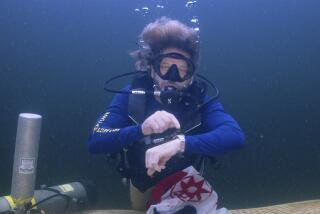COUSTEAU’S 5-YEAR GRAND FINALE : A FAREWELL VOYAGE OF REDISCOVERY
- Share via
ABOARD THE ALCYONE — The creatures in Mexico’s Sea of Cortez have their own way of throwing out the welcome mat for Jacques Cousteau and his crew of French divers.
One grand manta ray vaults out of the water high enough to do a triple back flip, then splashes back just yards from the bow.
A school of dolphins, with at least one baby in tow, swims over to the Alcyone, Cousteau’s turbine-and-computer-powered wind ship without sails.
Flying fish streak across the bow and a lone sea lion pops his snout above the water and curiously peeks at the passing humans.
It’s almost as if they know Cousteau is on his final voyage.
He has launched his most ambitious expedition since 1968 when he began the series “The Undersea World of Jacques Cousteau”-- a five-year “Rediscovery of the World” excursion that will circumnavigate the globe.
The journey will take him to China’s Yangtze River, Haiti’s waters of sorrow, South America’s Cape Horn and Mexico’s Sea of Cortez, to name just a few.
In 20 one-hour television specials, Cousteau and crews aboard the Alcyone and Calypso will visit lands discovered centuries ago by the likes of Christopher Columbus, Charles Darwin and Amerigo Vespucci. The $15-million voyage will be presented on the Turner Broadcasting System’s WTBS superstation. Next to air is “Cuba: Waters of Destiny,” Sept. 10.
Cousteau will be 80 when the voyage ends in 1990 and plans to turn the reins over to his son, Jean-Michel Cousteau.
“What we hope to accomplish is simple--improve the quality of life,” Cousteau says. “My aim is to better understand what’s going on in this damn world.”
Cousteau, called the “father of undersea archeology,” began diving in the 1930s and has been responsible for many developments in undersea exploration: the aqualung in 1943, underwater TV equipment in 1951, the diving saucer in 1959.
But more importantly, he has become a whistle-blower for the environment, informing of past and present and warning of future disasters. He speaks for the creatures of the sea, land and air, and believes that humans are the strangest of all.
“Hunters are working to diminish the quality of the race,” Cousteau says. “I would commit suicide if I were a hunter.”
But he didn’t always feel that way. As a youth he made a wager that he could take a curtain rod and use it to spear a fish. He won the bet. “I did a couple of stupid things like this because I was baffled by the familiarity of the fish,” Cousteau says.
“When we didn’t know any better, we’d jump into a Zodiac and chase a whale,” says Jean-Michel, 48. “That’s harassment. Now that we know better, we don’t run after whales.”
Few crew members even eat fish anymore. “I don’t like eating a pet,” says chief diver Dominique Sumain, who’s been with Cousteau for 21 years.
Although curiosity is still his beacon, Cousteau’s focus has undergone a shift.
Less than a third of the first special from the five-year voyage, “Haiti: “The Waters of Sorrow,” is devoted to underwater shots. What emerges is a sociological portrait of a nation that has used up its land and water resources. It is a sad story, and one that is too late to correct.
The rediscovery series has little to do with the behavior of undersea creatures but deals with how human behavior affects natural resources. When the Alcyone cuts across the Pacific to Eniwetok atoll, it will investigate the long-term impact of U.S. nuclear bomb tests decades ago.
Still, Cousteau’s camera will focus again and again on the wonders of the natural world.
Here in the Sea of Cortez, the red rock mountains of Baja jut from the ocean as his crew searches for mantas and whales. The waters have been overfished, the land is about to be overdeveloped.
To the south, the waters teem with hundreds of hammerhead sharks, all about the same size--and all female.
“We don’t know why,” says Jean-Michel. “It is one of the mysteries.”
And for Cousteau, the hammerhead sharks, the dolphin, the manta rays, the whales--they are his reason for living.
“My dream, it is coming true every day,” he says.
More to Read
Sign up for Essential California
The most important California stories and recommendations in your inbox every morning.
You may occasionally receive promotional content from the Los Angeles Times.











